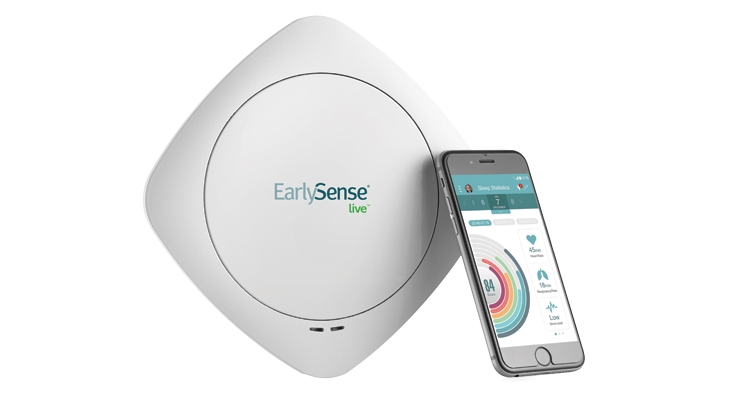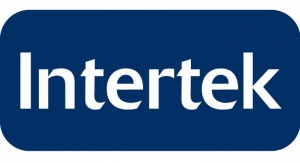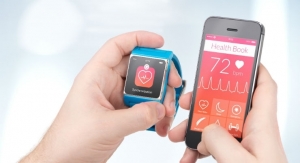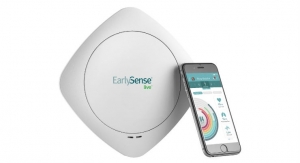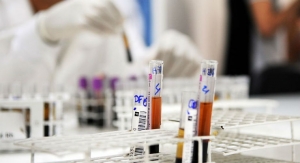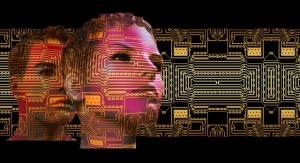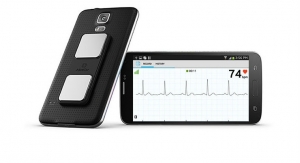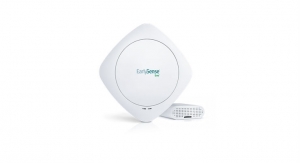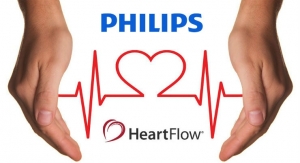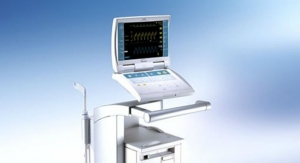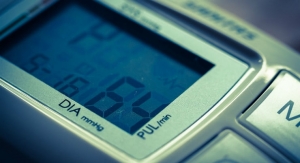Sam Brusco, Associate Editor10.05.17
Atrial fibrillation (AFib) is one of the most prevalent heart rhythm disorders. According to a 2014 Journal of the American College of Cardiology study, anywhere between 2.7 and 6.1 million U.S. citizens are living with AFib. Patients with AFib are five times more likely than healthy individuals to have a stroke, and it can be difficult to detect. Symptoms of AFib might include palpitations, anxiety, shortness of breath, chest pain, and sweating—among others—but these are often poorly correlated with AFib presence, and sometimes AFib episodes can be completely asymptomatic.
Typically, physicians have used these symptoms and external monitoring to diagnose AFib. This is usually sufficient for patients in the hospital who have clinicians nearby to address AFib occurrences, but many episodes occur at home and without warning. These are the most dangerous of all because patients may not even know they’re in danger without proper monitoring equipment, which is incredibly difficult (and expensive) to house in most patients’ homes.
AliveCor’s U.S. Food and Drug Administration (FDA)-cleared Kardia Mobile device and app-based service has responded to this issue with clinically validated mobile electrocardiogram (ECG) technology to detect AFib on the go. The Kardia Mobile sensor rests on the fingers or chest to record an ECG, converting electrical impulses into ultrasound signals that are transmitted to a mobile device’s microphone. Since the single-channel ECG sensor fits onto most mobile devices, heart rhythm abnormalities can be detected in as low as 30 seconds and can be shared with a doctor via the accompanying Kardia app.
Dispelling accounts of overhyped mobile health apps that fail to back their claims with clinical studies, findings from the 2017 European Society of Cardiology Congress determined AliveCor’s 30-second ECG to be the real deal. Researchers found that patients using Kardia Mobile had a fourfold increase in AFib detection, Kardia’s accuracy was on par with physicians, it could spot asymptomatic AFib more effectively than traditional methods, and was found easy to use by senior citizens. The latter was particularly important because senior citizens represent the largest population at risk for AFib, yet can be a challenging group for which to introduce new technology.
“What I find so compelling about Kardia is how it empowers my patient, making them much more proactive in their own healthcare,” Dr. Theodore Takata, a cardiac electrophysiologist, said in announcing the technology’s funding by Omron Healthcare and the Mayo Clinic. “Reviewing data this quickly also lets me make important medical decisions, accelerating the time to diagnosis and avoiding unnecessary healthcare utilization.”
Takata succinctly summarizes perhaps the most beneficial aspects of using a mobile health (mHealth) tool to manage an ongoing condition: patient empowerment and proactivity, accelerated clinical response and diagnosis, and healthcare savings. When patients are given the opportunity to input health data through either self-reported written accounts, sensors like Kardia Mobile, or self-administered diagnostic tests, they can gain a more complete picture of health than through a visit to the clinic. Managing a chronic illness is not an easy endeavor, and patients often feel burdened or limited because of the daily difficulties and procedures involved. mHealth tools allow patients to observe the state of their health in real-time and make proactive decisions about managing their disease.
“There is a lot of room for digital health tools to ease illness management. We are seeing the very beginning of this trend within a limited context,” explained Waqaas Al-Siddiq, founder and CEO of Redwood City, Calif.-based Biotricity, a company developing digital solutions designed to aid chronic disease prevention and management.
“Today, these apps primarily focus on medication reminders and promote patient mobility and exercise. Healthcare professionals struggle to ensure day-to-day medication adherence and facilitate patient mobility, both of which are costly and time-consuming. Digital health devices promote medication adherence and mobility by issuing reminders and increasing motivation. This both aids illness management and accelerates recovery times, enabling healthcare professionals to better understand what is working and what is not in terms of treatment plans.”
Historically, treatment plans for chronic illnesses could only be altered through a visit to the clinic, because it was the only way to assess the patient’s health and make adjustments based on test results. This is simply not intensive enough for some illnesses—diabetes, for example—which may require treatment adjustment at a moment’s notice. Clinicians may not have the bandwidth to see a patient, or patients may not have the resources to support repeat clinic visits. Conditions can worsen under these circumstances and patients may be hospitalized—an even costlier outcome. In addition to a picture of health formed by information input into the system, a mobile health tool offers near-constant communication between the patient and physician. Combined, these factors can cut spending for patients and boost outcomes for both parties.
“Clinicians who are under pressure to reduce costs and improve outcomes are in favor of using mHealth tools,” commented Matt Lowe, executive vice president of MasterControl, a Salt Lake City, Utah-based provider of industry-specific quality and compliance software solutions and services. “Survey results released by the PwC Health Research Institute (HRI) indicate nearly 90 percent of U.S. clinicians think mobile apps will become essential to patient health management over the next five years.
Seventy-four percent of the HRI respondents said they would be willing to use data streamed from a mobile app or device to check for ear infection; 53 percent were in favor of using a mobile app or device to analyze urine, and 20 percent have already prescribed nutrition and weight loss apps.”
Managing diabetes represents one area where mobile digital health tools could ease the burden on patients, clinicians, and caregivers. Because the disease requires paying close attention to diet, exercise, sleep schedules, and just about every facet of health data one can collect, it can be difficult for patients to keep tabs on everything. Mobile health tools can pick up the slack in these circumstances.
“Management of diabetes will be less burdensome for the patient, physician, and healthcare system due to the use of mobile health technologies,” said Michael Lynch, managing consultant for Intertek, a London, U.K.-based total quality assurance provider to industries worldwide. “For the patient, integration of blood glucose data with physiologic data (blood pressure) and lifestyle data (how far did you walk? what did you eat?) can provide a better therapeutic regimen for insulin dosage. There will be less risk of over- or under-dosing, resulting in fewer side effects and more effective treatment of the condition.”
“Historically, the best improvement in managing chronic disease through mHealth has been in diabetes,” observed Avner Halperin, CEO of EarlySense, a Waltham, Mass.-based developer of sensors and analytics for continuous patient monitoring in hospitals, alternate care, and homes. “The ability to closely track dynamic glucose levels at home empowers patients to live longer, healthier lives with significantly fewer complications. Diabetes is relatively ‘easy’ to control with a mobile health tool because a single parameter drives a simple, effective self-intervention.”
It’s strange to consider a disease that drastically changes lifestyle as easy to control, but an mHealth tool can make it so. According to Halperin, however, other diseases with a more complicated set of “parameters” can be a struggle to manage using a mobile digital tool.
“Congestive heart failure, COPD, and asthma are more challenging to measure and control,” he went on. “But recent developments that allow continuous, accurate, and burden-free measurement of cardiac and respiratory parameters at home will empower patients and caregivers to provide proactive care that will significantly improve outcomes. This is crucial with the growing rates of chronic disease.”
Hardware, Software, and the Cloud
Mobile health technology leverages smartphones, tablets, and other mobile devices to deliver healthcare as well as preventative health services. Without corresponding smartphone technology innovation, mHealth systems could not progress nearly as quickly as they have in recent years.
Burgeoning mHealth technologies on a smartphone platform are revamping the way healthcare is delivered. Through mobile health apps and mobile-enabled electronic health records (EHRs) clinical information is easily and readily accessible. Secure text messaging and patient portals facilitate constant communication between patients and doctors. Remote healthcare and real-time monitoring (i.e., telemedicine) can deliver health services to difficult-to-reach regions of the world. And none of it would be possible without the device most are carrying in their pockets right now.
“Innovation is the name of the game in mHealth, and many innovations are centered directly on the smartphone,” said Lowe. “For example, the Australian company ResApp received funding by the Bill and Melinda Gates Foundation to develop an app that could be used to detect respiratory issues. Essentially, a doctor would ask the patient to cough into a smartphone. The app would help the doctor determine if the patient suffers from conditions such as pneumonia. Other examples in this category are Propeller Health, which combines an inhaler with a high-tech sensor; AsthmaMD, which pairs a peak flow meter and smartphone app; and iSonea, whose device measures and charts a user’s wheeze rate.”
There has been much interest in utilizing mHealth apps and wearable sensors to enable remote health monitoring and boost patient compliance with prescribed treatments. A significant number of companies are developing tools that measure biological factors like blood pressure, weight, and glucose as well as adherence behaviors like mobility and medication regimens. Clinicians can then keep track of patients at risk for serious health events—if a device detects elevated blood pressure or glucose, for instance, the provider would be alerted before an emergency room visit becomes necessary.
“Smart, low-cost sensors are now making their way to the homes as part of the mobile health revolution,” declared Halperin. “Historically, accurate medical data was only collected in hospitals with complex and expensive tools operated by highly trained technicians or nurses. Today, many of these sensors measure vital signs at home or on the move. The abundance of information is only part of the value creation, but it’s a critical first step.”
Equally as important as the hardware is artificial intelligence (AI) embedded into an mHealth system. AI in healthcare represents a collection of technologies allowing machines to sense, comprehend, act, and learn based on health data gathered from the aforementioned sensors. In recent years, the number of digital health companies using AI in their products has ballooned—according to a CB Insights report, over 100 AI-focused healthcare companies were formed in 2015, and 50 had raised their first equity rounds since January of that year.
AI strategies have become popular for mHealth systems because making sense of the data captured through sensors or patient input can be difficult for clinicians to decipher. After all, collecting all that health data is essentially useless without some way to glean a trend for an actionable treatment adjustment.
“Collecting large amounts of health data is not valuable and interesting on its own,” Halperin continued. “Strong, deep learning algorithms are required to drive meaning and outcome. AI is key to delivering such analyses and delivering on the promise of clinically proven outcome improvement. Companies like Zebra Medical Technologies use AI to deliver automatic, accurate medical imaging analysis; AliveCor uses deep learning algorithms to diagnose arrhythmia at home; and EarlySense uses AI to determine when a significant change in heart or breathing parameters may indicate a health risk condition at the hospital or home.”
“The use of AI tools is revolutionizing mobile health and healthcare in general,” said Lynch. “Analyzing all the data that is collected and finding patterns or trends not immediately obvious will allow improvements in clinical outcomes, because the best therapy for that particular person or demographic can be applied. IBM has demonstrated this concept with Watson Health in several clinical areas.”
Cloud computing technology has become prevalent in healthcare organizations worldwide, and is significantly fueling mobile health technology innovation. Large data files—like a week’s worth of information collected from an ECG sensor—can be shared quite conveniently via a cloud solution. This augments efficiency for healthcare organizations and saves costs for both patients and clinics; professionals and patients can easily store and remotely access healthcare data generated by the mobile health tool.
“Cloud connectivity, big data, and mobile phones are working in a symbiotic way to push mobile health forward,” explained Al-Siddiq. “Connectivity to the cloud enables devices to access big data and rules engines to cross reference information collected from patients. Remote patient monitoring devices will have an exponential effect on the aforementioned technologies by generating vast amounts of data, improving big data algorithms and streamlining the diagnostic process.”
More broadly, the proliferation of the Internet of Things (IoT) network in healthcare has a great deal to offer mobile health tools. It signals an age of data-driven health decisions and care delivery in the form of “connected health,” where constant information streaming via embedded sensors produces a data baseline to detect individual or population-based trends.
“The principle of ICT (information communication technology)/internet anywhere, anytime, any device opens a new range of service offerings. Accessibility, connectivity, security, and strong authentication open the gates to telecare, where care providers and patients can be anywhere in the world,” explained Eric Van der Hulst, innovation manager of health at imec, a Leuven, Belgium-based R&D and innovation hub in nanoelectronics and digital technologies. “This includes a new form of competition (on quality, reputation, and price) in new markets. Semantic data models on health, artificial intelligence, and population healthcare will lead to algorithms that improve all the time, and may one day become personalized for the patient.”
Upward Mobility
In a Forbes article entitled “Digital Therapeutics: The Future of Health Care Will Be App-Based” published July this year, contributor Elad Natanson concluded “…someday, apps that help people manage illness and prevent long-term disease will no longer have a special name. They will just be another form of software on our phones.” The rise of digital therapeutics—another, perhaps snappier name for mHealth tools—is the next logical step in a healthcare system moving toward individualized care delivery.
“Personalized medicine is a hot trend that continues to edge closer to mainstream,” predicted Lowe. “Pharmacogenomics and genome sequencing could be in the future of mHealth. This would help tailor treatment at never-before-seen levels and reduce billions of dollars in healthcare spending. Without a doubt, the next frontier of medicine may very well be in your pocket, on your smartphone.”
A recent example of mHealth in the mainstream: Just a few weeks ago, the FDA permitted marketing of Pear Therapeutics’ Reset device, the first mobile medical application to treat alcohol, cocaine, marijuana, and stimulant substance use disorders (SUD). The Reset system consists of a patient application and clinician dashboard, through which cognitive behavioral therapy is administered to teach the user skills intended to increase abstinence from substance abuse and increase retention in outpatient therapy programs. It’s meant to be used in tandem with outpatient therapy as well as a contingency management system, which uses a series of incentives to reward patients for adherence to their treatment program. Clinical data showed a statistically significant increase in adherence to abstinence for the patients with alcohol, cocaine, marijuana and stimulant SUD in those who used Reset, 40.3 percent, compared to the patients who did not, 17.6 percent.
The fact that mHealth tools now exist, however, is not enough to curry patients’ favor toward the emerging solution.
“The difficulty of introducing future mHealth tools lies in the digital literacy—particularly in usability and training,” forecasted Van der Hulst. “Other challenges to future mHealth tool establishment include implementation and adoption (resistance and change management), trust (security, privacy), and foremost, financial organization of the health system.”
Encouraging clinicians to adopt mHealth tools may be more challenging than convincing patients. Patients stand to save money by reducing clinic and/or emergency room visits, but it’s difficult to know what the prognosis will be for doctors. Ideally, healthcare would continue to shift toward a value-based approach so clinicians are paid based on positive outcomes—the ultimate goal of a mobile digital health tool. In a value-based system (in addition to improved healthcare delivery) both patients and clinicians stand to have a healthy wallet, as well.
“The future is a coupling of personalized medical monitoring devices with mobile health AI to create digital health coaches that actively monitor and engage with the patient to improve outcomes,” Al-Siddiq foresees. “We will see patients less burdened with manual input of information and more passionate about their health as technology becomes more automated, intelligent, and active—providing patients with the right tools at the right time. The future will focus on personalized mHealth, in which the software adapts to the individual patient based on the clinical data collected from their personal medical devices. Disease management will become effective and efficient, helping us increase the quality of life as longevity becomes more ubiquitous.”
In addition to the broader effects of future increased mHealth system adoption, the continued innovation of both smartphone and medical technology will drive proliferation of novel mobile health inventions.
“I predict the Medical Internet of Things (MIoT) revolution of devices connecting to the ecosystem of home, city, and industry,” stated Chris Wyman, a national medical executive of Intertek. “Devices will communicate through smart actuators, sensors, and applications. Heat maps of populations will track vitals, using cognitive applications to notify, warn, and improve consumer health and patient outcomes while extending lifespan longevity and expectancy. The critical component of this technology’s continued evolution hinges on the protection of patient data and network cybersecurity.”
In fact, mobile health technologies leveraging AI, cloud computing, and embedded sensors may even be rendered obsolete if the current pace of the technology’s evolution continues.
“By 2030, big data, wearable sensors, and personalized medicine will all be old news,” concluded Halperin. “Developments like robotic surgery and genomically optimized medicine will allow us to live longer and healthier lives. With over 100 million seniors and more than a million centenarians in the U.S., the key challenge will be to improve mental well-being as effectively as we have improved physical health. The most precious resource will be the time of caregivers—professionals and family that will almost be ‘outnumbered’ by seniors. Patients in hospitals and residents at home will be hungry for the human connection. A key objective for medtech in 2030 will be to optimize human interaction. Sensors and analytics will communicate the need for interaction and provide caregivers with the best time to connect/intervene most efficiently, with the right data and advanced analytics. All of this will be focused on optimizing the ‘ROM’ (Return On every Minute) of caregiver time.”
Interviews with each of this article's sources can be accessed via the links below:
Typically, physicians have used these symptoms and external monitoring to diagnose AFib. This is usually sufficient for patients in the hospital who have clinicians nearby to address AFib occurrences, but many episodes occur at home and without warning. These are the most dangerous of all because patients may not even know they’re in danger without proper monitoring equipment, which is incredibly difficult (and expensive) to house in most patients’ homes.
AliveCor’s U.S. Food and Drug Administration (FDA)-cleared Kardia Mobile device and app-based service has responded to this issue with clinically validated mobile electrocardiogram (ECG) technology to detect AFib on the go. The Kardia Mobile sensor rests on the fingers or chest to record an ECG, converting electrical impulses into ultrasound signals that are transmitted to a mobile device’s microphone. Since the single-channel ECG sensor fits onto most mobile devices, heart rhythm abnormalities can be detected in as low as 30 seconds and can be shared with a doctor via the accompanying Kardia app.
Dispelling accounts of overhyped mobile health apps that fail to back their claims with clinical studies, findings from the 2017 European Society of Cardiology Congress determined AliveCor’s 30-second ECG to be the real deal. Researchers found that patients using Kardia Mobile had a fourfold increase in AFib detection, Kardia’s accuracy was on par with physicians, it could spot asymptomatic AFib more effectively than traditional methods, and was found easy to use by senior citizens. The latter was particularly important because senior citizens represent the largest population at risk for AFib, yet can be a challenging group for which to introduce new technology.
“What I find so compelling about Kardia is how it empowers my patient, making them much more proactive in their own healthcare,” Dr. Theodore Takata, a cardiac electrophysiologist, said in announcing the technology’s funding by Omron Healthcare and the Mayo Clinic. “Reviewing data this quickly also lets me make important medical decisions, accelerating the time to diagnosis and avoiding unnecessary healthcare utilization.”
Takata succinctly summarizes perhaps the most beneficial aspects of using a mobile health (mHealth) tool to manage an ongoing condition: patient empowerment and proactivity, accelerated clinical response and diagnosis, and healthcare savings. When patients are given the opportunity to input health data through either self-reported written accounts, sensors like Kardia Mobile, or self-administered diagnostic tests, they can gain a more complete picture of health than through a visit to the clinic. Managing a chronic illness is not an easy endeavor, and patients often feel burdened or limited because of the daily difficulties and procedures involved. mHealth tools allow patients to observe the state of their health in real-time and make proactive decisions about managing their disease.
“There is a lot of room for digital health tools to ease illness management. We are seeing the very beginning of this trend within a limited context,” explained Waqaas Al-Siddiq, founder and CEO of Redwood City, Calif.-based Biotricity, a company developing digital solutions designed to aid chronic disease prevention and management.
“Today, these apps primarily focus on medication reminders and promote patient mobility and exercise. Healthcare professionals struggle to ensure day-to-day medication adherence and facilitate patient mobility, both of which are costly and time-consuming. Digital health devices promote medication adherence and mobility by issuing reminders and increasing motivation. This both aids illness management and accelerates recovery times, enabling healthcare professionals to better understand what is working and what is not in terms of treatment plans.”
Historically, treatment plans for chronic illnesses could only be altered through a visit to the clinic, because it was the only way to assess the patient’s health and make adjustments based on test results. This is simply not intensive enough for some illnesses—diabetes, for example—which may require treatment adjustment at a moment’s notice. Clinicians may not have the bandwidth to see a patient, or patients may not have the resources to support repeat clinic visits. Conditions can worsen under these circumstances and patients may be hospitalized—an even costlier outcome. In addition to a picture of health formed by information input into the system, a mobile health tool offers near-constant communication between the patient and physician. Combined, these factors can cut spending for patients and boost outcomes for both parties.
“Clinicians who are under pressure to reduce costs and improve outcomes are in favor of using mHealth tools,” commented Matt Lowe, executive vice president of MasterControl, a Salt Lake City, Utah-based provider of industry-specific quality and compliance software solutions and services. “Survey results released by the PwC Health Research Institute (HRI) indicate nearly 90 percent of U.S. clinicians think mobile apps will become essential to patient health management over the next five years.
Seventy-four percent of the HRI respondents said they would be willing to use data streamed from a mobile app or device to check for ear infection; 53 percent were in favor of using a mobile app or device to analyze urine, and 20 percent have already prescribed nutrition and weight loss apps.”
Managing diabetes represents one area where mobile digital health tools could ease the burden on patients, clinicians, and caregivers. Because the disease requires paying close attention to diet, exercise, sleep schedules, and just about every facet of health data one can collect, it can be difficult for patients to keep tabs on everything. Mobile health tools can pick up the slack in these circumstances.
“Management of diabetes will be less burdensome for the patient, physician, and healthcare system due to the use of mobile health technologies,” said Michael Lynch, managing consultant for Intertek, a London, U.K.-based total quality assurance provider to industries worldwide. “For the patient, integration of blood glucose data with physiologic data (blood pressure) and lifestyle data (how far did you walk? what did you eat?) can provide a better therapeutic regimen for insulin dosage. There will be less risk of over- or under-dosing, resulting in fewer side effects and more effective treatment of the condition.”
“Historically, the best improvement in managing chronic disease through mHealth has been in diabetes,” observed Avner Halperin, CEO of EarlySense, a Waltham, Mass.-based developer of sensors and analytics for continuous patient monitoring in hospitals, alternate care, and homes. “The ability to closely track dynamic glucose levels at home empowers patients to live longer, healthier lives with significantly fewer complications. Diabetes is relatively ‘easy’ to control with a mobile health tool because a single parameter drives a simple, effective self-intervention.”
It’s strange to consider a disease that drastically changes lifestyle as easy to control, but an mHealth tool can make it so. According to Halperin, however, other diseases with a more complicated set of “parameters” can be a struggle to manage using a mobile digital tool.
“Congestive heart failure, COPD, and asthma are more challenging to measure and control,” he went on. “But recent developments that allow continuous, accurate, and burden-free measurement of cardiac and respiratory parameters at home will empower patients and caregivers to provide proactive care that will significantly improve outcomes. This is crucial with the growing rates of chronic disease.”
Hardware, Software, and the Cloud
Mobile health technology leverages smartphones, tablets, and other mobile devices to deliver healthcare as well as preventative health services. Without corresponding smartphone technology innovation, mHealth systems could not progress nearly as quickly as they have in recent years.
Burgeoning mHealth technologies on a smartphone platform are revamping the way healthcare is delivered. Through mobile health apps and mobile-enabled electronic health records (EHRs) clinical information is easily and readily accessible. Secure text messaging and patient portals facilitate constant communication between patients and doctors. Remote healthcare and real-time monitoring (i.e., telemedicine) can deliver health services to difficult-to-reach regions of the world. And none of it would be possible without the device most are carrying in their pockets right now.
“Innovation is the name of the game in mHealth, and many innovations are centered directly on the smartphone,” said Lowe. “For example, the Australian company ResApp received funding by the Bill and Melinda Gates Foundation to develop an app that could be used to detect respiratory issues. Essentially, a doctor would ask the patient to cough into a smartphone. The app would help the doctor determine if the patient suffers from conditions such as pneumonia. Other examples in this category are Propeller Health, which combines an inhaler with a high-tech sensor; AsthmaMD, which pairs a peak flow meter and smartphone app; and iSonea, whose device measures and charts a user’s wheeze rate.”
There has been much interest in utilizing mHealth apps and wearable sensors to enable remote health monitoring and boost patient compliance with prescribed treatments. A significant number of companies are developing tools that measure biological factors like blood pressure, weight, and glucose as well as adherence behaviors like mobility and medication regimens. Clinicians can then keep track of patients at risk for serious health events—if a device detects elevated blood pressure or glucose, for instance, the provider would be alerted before an emergency room visit becomes necessary.
“Smart, low-cost sensors are now making their way to the homes as part of the mobile health revolution,” declared Halperin. “Historically, accurate medical data was only collected in hospitals with complex and expensive tools operated by highly trained technicians or nurses. Today, many of these sensors measure vital signs at home or on the move. The abundance of information is only part of the value creation, but it’s a critical first step.”
Equally as important as the hardware is artificial intelligence (AI) embedded into an mHealth system. AI in healthcare represents a collection of technologies allowing machines to sense, comprehend, act, and learn based on health data gathered from the aforementioned sensors. In recent years, the number of digital health companies using AI in their products has ballooned—according to a CB Insights report, over 100 AI-focused healthcare companies were formed in 2015, and 50 had raised their first equity rounds since January of that year.
AI strategies have become popular for mHealth systems because making sense of the data captured through sensors or patient input can be difficult for clinicians to decipher. After all, collecting all that health data is essentially useless without some way to glean a trend for an actionable treatment adjustment.
“Collecting large amounts of health data is not valuable and interesting on its own,” Halperin continued. “Strong, deep learning algorithms are required to drive meaning and outcome. AI is key to delivering such analyses and delivering on the promise of clinically proven outcome improvement. Companies like Zebra Medical Technologies use AI to deliver automatic, accurate medical imaging analysis; AliveCor uses deep learning algorithms to diagnose arrhythmia at home; and EarlySense uses AI to determine when a significant change in heart or breathing parameters may indicate a health risk condition at the hospital or home.”
“The use of AI tools is revolutionizing mobile health and healthcare in general,” said Lynch. “Analyzing all the data that is collected and finding patterns or trends not immediately obvious will allow improvements in clinical outcomes, because the best therapy for that particular person or demographic can be applied. IBM has demonstrated this concept with Watson Health in several clinical areas.”
Cloud computing technology has become prevalent in healthcare organizations worldwide, and is significantly fueling mobile health technology innovation. Large data files—like a week’s worth of information collected from an ECG sensor—can be shared quite conveniently via a cloud solution. This augments efficiency for healthcare organizations and saves costs for both patients and clinics; professionals and patients can easily store and remotely access healthcare data generated by the mobile health tool.
“Cloud connectivity, big data, and mobile phones are working in a symbiotic way to push mobile health forward,” explained Al-Siddiq. “Connectivity to the cloud enables devices to access big data and rules engines to cross reference information collected from patients. Remote patient monitoring devices will have an exponential effect on the aforementioned technologies by generating vast amounts of data, improving big data algorithms and streamlining the diagnostic process.”
More broadly, the proliferation of the Internet of Things (IoT) network in healthcare has a great deal to offer mobile health tools. It signals an age of data-driven health decisions and care delivery in the form of “connected health,” where constant information streaming via embedded sensors produces a data baseline to detect individual or population-based trends.
“The principle of ICT (information communication technology)/internet anywhere, anytime, any device opens a new range of service offerings. Accessibility, connectivity, security, and strong authentication open the gates to telecare, where care providers and patients can be anywhere in the world,” explained Eric Van der Hulst, innovation manager of health at imec, a Leuven, Belgium-based R&D and innovation hub in nanoelectronics and digital technologies. “This includes a new form of competition (on quality, reputation, and price) in new markets. Semantic data models on health, artificial intelligence, and population healthcare will lead to algorithms that improve all the time, and may one day become personalized for the patient.”
Upward Mobility
In a Forbes article entitled “Digital Therapeutics: The Future of Health Care Will Be App-Based” published July this year, contributor Elad Natanson concluded “…someday, apps that help people manage illness and prevent long-term disease will no longer have a special name. They will just be another form of software on our phones.” The rise of digital therapeutics—another, perhaps snappier name for mHealth tools—is the next logical step in a healthcare system moving toward individualized care delivery.
“Personalized medicine is a hot trend that continues to edge closer to mainstream,” predicted Lowe. “Pharmacogenomics and genome sequencing could be in the future of mHealth. This would help tailor treatment at never-before-seen levels and reduce billions of dollars in healthcare spending. Without a doubt, the next frontier of medicine may very well be in your pocket, on your smartphone.”
A recent example of mHealth in the mainstream: Just a few weeks ago, the FDA permitted marketing of Pear Therapeutics’ Reset device, the first mobile medical application to treat alcohol, cocaine, marijuana, and stimulant substance use disorders (SUD). The Reset system consists of a patient application and clinician dashboard, through which cognitive behavioral therapy is administered to teach the user skills intended to increase abstinence from substance abuse and increase retention in outpatient therapy programs. It’s meant to be used in tandem with outpatient therapy as well as a contingency management system, which uses a series of incentives to reward patients for adherence to their treatment program. Clinical data showed a statistically significant increase in adherence to abstinence for the patients with alcohol, cocaine, marijuana and stimulant SUD in those who used Reset, 40.3 percent, compared to the patients who did not, 17.6 percent.
The fact that mHealth tools now exist, however, is not enough to curry patients’ favor toward the emerging solution.
“The difficulty of introducing future mHealth tools lies in the digital literacy—particularly in usability and training,” forecasted Van der Hulst. “Other challenges to future mHealth tool establishment include implementation and adoption (resistance and change management), trust (security, privacy), and foremost, financial organization of the health system.”
Encouraging clinicians to adopt mHealth tools may be more challenging than convincing patients. Patients stand to save money by reducing clinic and/or emergency room visits, but it’s difficult to know what the prognosis will be for doctors. Ideally, healthcare would continue to shift toward a value-based approach so clinicians are paid based on positive outcomes—the ultimate goal of a mobile digital health tool. In a value-based system (in addition to improved healthcare delivery) both patients and clinicians stand to have a healthy wallet, as well.
“The future is a coupling of personalized medical monitoring devices with mobile health AI to create digital health coaches that actively monitor and engage with the patient to improve outcomes,” Al-Siddiq foresees. “We will see patients less burdened with manual input of information and more passionate about their health as technology becomes more automated, intelligent, and active—providing patients with the right tools at the right time. The future will focus on personalized mHealth, in which the software adapts to the individual patient based on the clinical data collected from their personal medical devices. Disease management will become effective and efficient, helping us increase the quality of life as longevity becomes more ubiquitous.”
In addition to the broader effects of future increased mHealth system adoption, the continued innovation of both smartphone and medical technology will drive proliferation of novel mobile health inventions.
“I predict the Medical Internet of Things (MIoT) revolution of devices connecting to the ecosystem of home, city, and industry,” stated Chris Wyman, a national medical executive of Intertek. “Devices will communicate through smart actuators, sensors, and applications. Heat maps of populations will track vitals, using cognitive applications to notify, warn, and improve consumer health and patient outcomes while extending lifespan longevity and expectancy. The critical component of this technology’s continued evolution hinges on the protection of patient data and network cybersecurity.”
In fact, mobile health technologies leveraging AI, cloud computing, and embedded sensors may even be rendered obsolete if the current pace of the technology’s evolution continues.
“By 2030, big data, wearable sensors, and personalized medicine will all be old news,” concluded Halperin. “Developments like robotic surgery and genomically optimized medicine will allow us to live longer and healthier lives. With over 100 million seniors and more than a million centenarians in the U.S., the key challenge will be to improve mental well-being as effectively as we have improved physical health. The most precious resource will be the time of caregivers—professionals and family that will almost be ‘outnumbered’ by seniors. Patients in hospitals and residents at home will be hungry for the human connection. A key objective for medtech in 2030 will be to optimize human interaction. Sensors and analytics will communicate the need for interaction and provide caregivers with the best time to connect/intervene most efficiently, with the right data and advanced analytics. All of this will be focused on optimizing the ‘ROM’ (Return On every Minute) of caregiver time.”
Interviews with each of this article's sources can be accessed via the links below:

